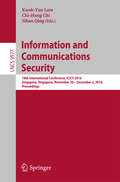 Information and Communications Security
1532715
Information and Communications Security
1532715
|
Sihan Qing
Kwok-Yan Lam
Chi-Hung Chi
|
9783319500119 |
2000 |
Contains images
|
|
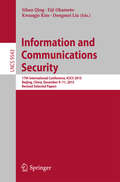 Information and Communications Security
1418471
Information and Communications Security
1418471
|
Sihan Qing
Eiji Okamoto
Kwangjo Kim
Dongmei Liu
|
9783319298146 |
2016 |
Contains images
|
|
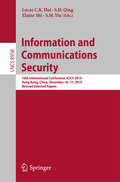 Information and Communications Security
1410869
Information and Communications Security
1410869
|
Lucas C. K. Hui
S. H. Qing
Elaine Shi
S. M. Yiu
|
9783319219660 |
2015 |
Contains images
|
|
 Information and Communications Security: 17th International Conference, ICICS 2015, Beijing, China, December 9-11, 2015, Revised Selected Papers (Lecture Notes in Computer Science #9543)
4095620
Information and Communications Security: 17th International Conference, ICICS 2015, Beijing, China, December 9-11, 2015, Revised Selected Papers (Lecture Notes in Computer Science #9543)
4095620
|
Sihan Qing
Eiji Okamoto
Kwangjo Kim
Dongmei Liu
|
9783319298146 |
2016 |
Contains images
|
|
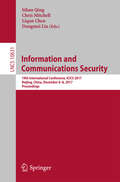 Information and Communications Security: 17th International Conference, Icics 2015, Beijing, China, December 9-11, 2015, Revised Selected Papers (Lecture Notes In Computer Science #9543)
2015298
Information and Communications Security: 17th International Conference, Icics 2015, Beijing, China, December 9-11, 2015, Revised Selected Papers (Lecture Notes In Computer Science #9543)
2015298
|
Chris Mitchell
Liqun Chen
Sihan Qing
Dongmei Liu
|
9783319895000 |
2018 |
Contains images
|
|
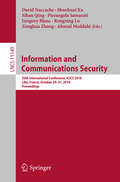 Information and Communications Security: 20th International Conference, ICICS 2018, Lille, France, October 29-31, 2018, Proceedings (Lecture Notes in Computer Science #11149)
2333229
Information and Communications Security: 20th International Conference, ICICS 2018, Lille, France, October 29-31, 2018, Proceedings (Lecture Notes in Computer Science #11149)
2333229
|
Rongxing Lu
Pierangela Samarati
David Naccache
Gregory Blanc
Shouhuai Xu
Sihan Qing
Zonghua Zhang
Ahmed Meddahi
|
9783030019501 |
2018 |
Contains images
|
|
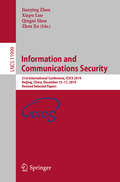 Information and Communications Security: 21st International Conference, ICICS 2019, Beijing, China, December 15–17, 2019, Revised Selected Papers (Lecture Notes in Computer Science #11999)
3700133
Information and Communications Security: 21st International Conference, ICICS 2019, Beijing, China, December 15–17, 2019, Revised Selected Papers (Lecture Notes in Computer Science #11999)
3700133
|
Jianying Zhou
Xiapu Luo
Qingni Shen
Zhen Xu
|
9783030415792 |
2020 |
Contains images
|
|
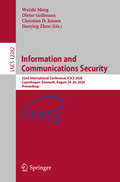 Information and Communications Security: 22nd International Conference, ICICS 2020, Copenhagen, Denmark, August 24–26, 2020, Proceedings (Lecture Notes in Computer Science #12282)
3700900
Information and Communications Security: 22nd International Conference, ICICS 2020, Copenhagen, Denmark, August 24–26, 2020, Proceedings (Lecture Notes in Computer Science #12282)
3700900
|
Jianying Zhou
Dieter Gollmann
Weizhi Meng
Christian D. Jensen
|
9783030610784 |
2020 |
Contains images
|
|
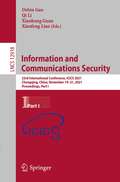 Information and Communications Security: 23rd International Conference, ICICS 2021, Chongqing, China, November 19-21, 2021, Proceedings, Part I (Lecture Notes in Computer Science #12918)
4281927
Information and Communications Security: 23rd International Conference, ICICS 2021, Chongqing, China, November 19-21, 2021, Proceedings, Part I (Lecture Notes in Computer Science #12918)
4281927
|
Qi Li
Xiaofeng Liao
Debin Gao
Xiaohong Guan
|
9783030868901 |
2021 |
Contains images
|
|
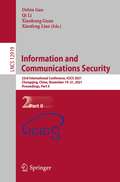 Information and Communications Security: 23rd International Conference, ICICS 2021, Chongqing, China, November 19-21, 2021, Proceedings, Part II (Lecture Notes in Computer Science #12919)
4281924
Information and Communications Security: 23rd International Conference, ICICS 2021, Chongqing, China, November 19-21, 2021, Proceedings, Part II (Lecture Notes in Computer Science #12919)
4281924
|
Qi Li
Xiaofeng Liao
Debin Gao
Xiaohong Guan
|
9783030880521 |
2021 |
Contains images
|
|
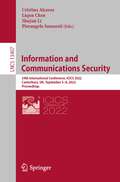 Information and Communications Security: 24th International Conference, ICICS 2022, Canterbury, UK, September 5–8, 2022, Proceedings (Lecture Notes in Computer Science #13407)
5919869
Information and Communications Security: 24th International Conference, ICICS 2022, Canterbury, UK, September 5–8, 2022, Proceedings (Lecture Notes in Computer Science #13407)
5919869
|
Shujun Li
Liqun Chen
Pierangela Samarati
Cristina Alcaraz
|
9783031157776 |
2022 |
Contains images
|
|
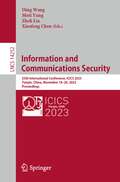 Information and Communications Security: 25th International Conference, ICICS 2023, Tianjin, China, November 18–20, 2023, Proceedings (Lecture Notes in Computer Science #14252)
5730907
Information and Communications Security: 25th International Conference, ICICS 2023, Tianjin, China, November 18–20, 2023, Proceedings (Lecture Notes in Computer Science #14252)
5730907
|
Ding Wang
Moti Yung
Zheli Liu
Xiaofeng Chen
|
9789819973569 |
2023 |
Contains images
|
|
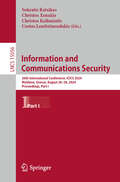 Information and Communications Security: 26th International Conference, ICICS 2024, Mytilene, Greece, August 26–28, 2024, Proceedings, Part I (Lecture Notes in Computer Science #15056)
6350042
Information and Communications Security: 26th International Conference, ICICS 2024, Mytilene, Greece, August 26–28, 2024, Proceedings, Part I (Lecture Notes in Computer Science #15056)
6350042
|
Sokratis Katsikas
Costas Lambrinoudakis
Christos Kalloniatis
Christos Xenakis
|
9789819787982 |
2025 |
Contains images
|
|
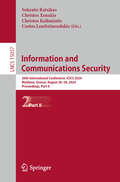 Information and Communications Security: 26th International Conference, ICICS 2024, Mytilene, Greece, August 26–28, 2024, Proceedings, Part II (Lecture Notes in Computer Science #15057)
6350107
Information and Communications Security: 26th International Conference, ICICS 2024, Mytilene, Greece, August 26–28, 2024, Proceedings, Part II (Lecture Notes in Computer Science #15057)
6350107
|
Sokratis Katsikas
Costas Lambrinoudakis
Christos Kalloniatis
Christos Xenakis
|
9789819788019 |
2025 |
Contains images
|
|
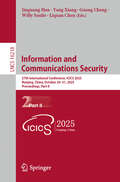 Information and Communications Security: 27th International Conference, ICICS 2025, Nanjing, China, October 29–31, 2025, Proceedings, Part II (Lecture Notes in Computer Science #16218)
6848022
Information and Communications Security: 27th International Conference, ICICS 2025, Nanjing, China, October 29–31, 2025, Proceedings, Part II (Lecture Notes in Computer Science #16218)
6848022
|
Yang Xiang
Jinguang Han
Willy Susilo
Guang Cheng
Liquan Chen
|
9789819535439 |
2026 |
Contains images
|
|
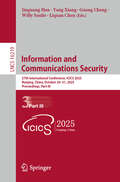 Information and Communications Security: 27th International Conference, ICICS 2025, Nanjing, China, October 29–31, 2025, Proceedings, Part III (Lecture Notes in Computer Science #16219)
6848023
Information and Communications Security: 27th International Conference, ICICS 2025, Nanjing, China, October 29–31, 2025, Proceedings, Part III (Lecture Notes in Computer Science #16219)
6848023
|
Yang Xiang
Jinguang Han
Willy Susilo
Guang Cheng
Liquan Chen
|
9789819535378 |
2026 |
Contains images
|
|
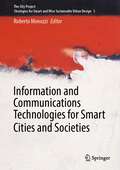 Information and Communications Technologies for Smart Cities and Societies (The City Project #5)
5715801
Information and Communications Technologies for Smart Cities and Societies (The City Project #5)
5715801
|
Roberto Menozzi
|
9783031394461 |
2024 |
Contains images
|
|
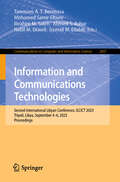 Information and Communications Technologies: Second International Libyan Conference, ILCICT 2023, Tripoli, Libya, September 4–6, 2023, Proceedings (Communications in Computer and Information Science #2097)
6117148
Information and Communications Technologies: Second International Libyan Conference, ILCICT 2023, Tripoli, Libya, September 4–6, 2023, Proceedings (Communications in Computer and Information Science #2097)
6117148
|
Tammam A. T. Benmusa
Mohamed Samir Elbuni
Ibrahim M. Saleh
Ahmed S. Ashur
Nabil M. Drawil
Issmail M. Ellabib
|
9783031626241 |
2024 |
Contains images
|
|
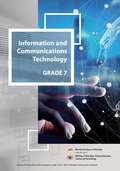 Information and Communications Technology class 7 - MIE
5868387
Information and Communications Technology class 7 - MIE
5868387
|
Mauritius Institute of Education
|
9789994944620 |
2021 |
Contains images
Contains image descriptions
|
Read Now
|
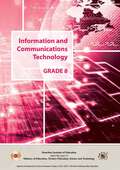 Information and Communications Technology class 8 - MIE
5760062
Information and Communications Technology class 8 - MIE
5760062
|
Mauritius Institute of Education
|
9789994944989 |
2021 |
Contains images
Contains image descriptions
|
Read Now
|
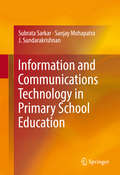 Information and Communications Technology in Primary School Education
1529284
Information and Communications Technology in Primary School Education
1529284
|
Sanjay Mohapatra
Subrata Sarkar
J. Sundarakrishnan
|
9783319424415 |
2017 |
Contains images
|
|
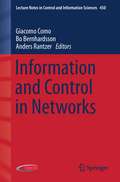 Information and Control in Networks
1389864
Information and Control in Networks
1389864
|
Giacomo Como
Bo Bernhardsson
Anders Rantzer
|
9783319021508 |
2014 |
Contains images
|
|
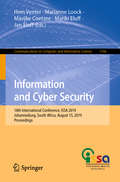 Information and Cyber Security: 18th International Conference, ISSA 2019, Johannesburg, South Africa, August 15, 2019, Proceedings (Communications in Computer and Information Science #1166)
3405246
Information and Cyber Security: 18th International Conference, ISSA 2019, Johannesburg, South Africa, August 15, 2019, Proceedings (Communications in Computer and Information Science #1166)
3405246
|
Jan Eloff
Hein Venter
Marianne Loock
Marijke Coetzee
Mariki Eloff
|
9783030432768 |
2020 |
Contains images
|
|
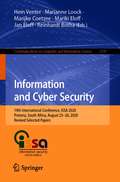 Information and Cyber Security: 19th International Conference, ISSA 2020, Pretoria, South Africa, August 25–26, 2020, Revised Selected Papers (Communications in Computer and Information Science #1339)
3754553
Information and Cyber Security: 19th International Conference, ISSA 2020, Pretoria, South Africa, August 25–26, 2020, Revised Selected Papers (Communications in Computer and Information Science #1339)
3754553
|
Jan Eloff
Hein Venter
Marianne Loock
Marijke Coetzee
Mariki Eloff
Reinhardt Botha
|
9783030660390 |
2020 |
Contains images
|
|
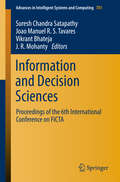 Information and Decision Sciences: Proceedings Of The 6th International Conference On Ficta (Advances In Intelligent Systems And Computing #701)
2013110
Information and Decision Sciences: Proceedings Of The 6th International Conference On Ficta (Advances In Intelligent Systems And Computing #701)
2013110
|
J. R. Mohanty
Suresh Chandra Satapathy
Vikrant Bhateja
Joao Manuel Tavares
|
9789811075636 |
2018 |
Contains images
|
|